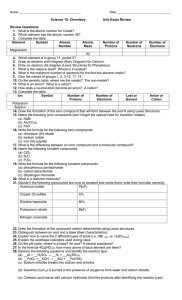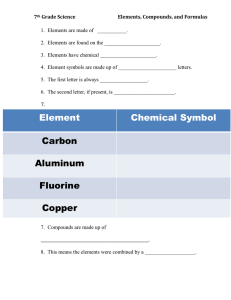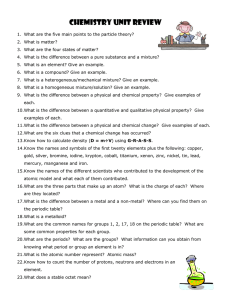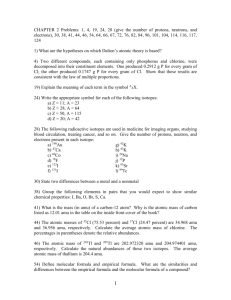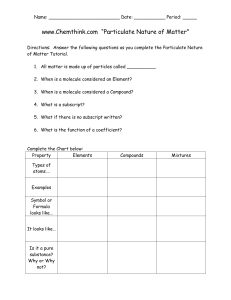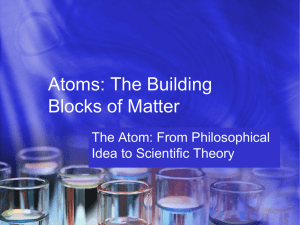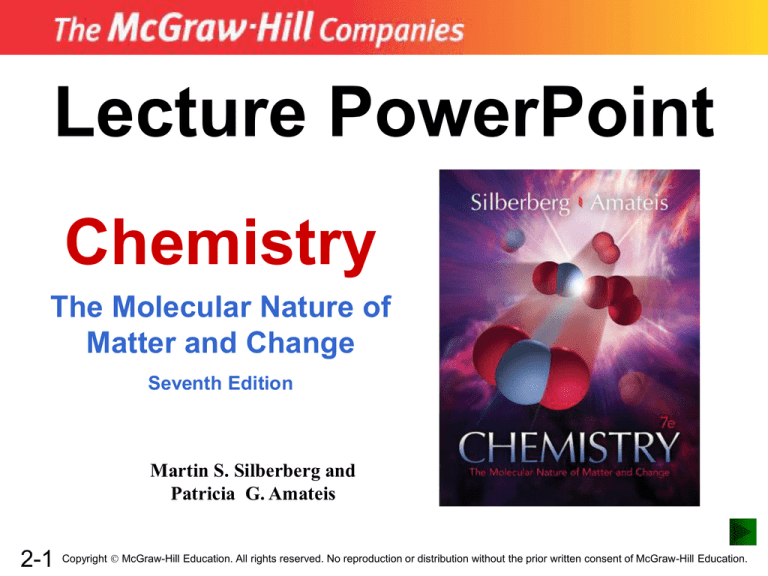
Lecture PowerPoint
Chemistry
The Molecular Nature of
Matter and Change
Seventh Edition
Martin S. Silberberg and
Patricia G. Amateis
2-1
Copyright McGraw-Hill Education. All rights reserved. No reproduction or distribution without the prior written consent of McGraw-Hill Education.
Chapter 2
The Components of Matter
2-2
Chapter 2: The Components of Matter
2.1 Elements, Compounds, and Mixtures:
An Atomic Overview
2.2 The Observations That Led to an Atomic View of Matter
2.3 Dalton’s Atomic Theory
2.4 The Observations That Led to the Nuclear Atom Model
2.5 The Atomic Theory Today
2-3
Chapter 2: The Components of Matter
2.6 Elements: A First Look at the Periodic Table
2.7 Compounds: Introduction to Bonding
2.8
Formulas, Names, and Masses of Compounds
2.9 Mixtures: Classification and Separation
2-4
Definitions for Components of Matter
Element - the simplest type of substance with unique physical and
chemical properties. An element consists of only one type of atom. It
cannot be broken down into any simpler substances by physical or
chemical means.
Molecule - a structure that consists of two or
more atoms that are chemically bound together
and thus behaves as an independent unit.
Figure 2.1
2-5
Definitions for Components of Matter
Compound – a substance
composed of two or more elements
that are chemically combined.
Figure 2.1
Mixture – a group of two or more
elements and/or compounds that
are physically intermingled.
2-6
Table 2.1
2-7
Some Properties of Sodium, Chlorine, and Sodium
Chloride.
Property
Sodium
Melting point
+
Chlorine
Sodium Chloride
97.8°C
-101°C
801°C
Boiling point
881.4°C
-34°C
1413°C
Color
Silvery
Yellow-green
Colorless (white)
Density
0.97 g/cm3
0.0032 g/cm3
2.16 g/cm3
Behavior in water
Reacts
Dissolves slightly
Dissolves freely
Sample Problem 2.1
PROBLEM:
Distinguishing Elements, Compounds, and
Mixtures at the Atomic Scale
The following scenes represent an atomic-scale view of
three samples of matter. Describe each sample as an
element, compound, or mixture.
Copyright McGraw-Hill Education. All rights reserved. No reproduction or distribution without the prior written consent of McGraw-Hill Education.
PLAN:
2-8
A sample that contains only one type of particle is either an
element or a compound. The particles of an element consist of
only one type of atom, whereas the particles of a compound have
two or more types of atom bonded together.
Sample Problem 2.1
SOLUTION:
Copyright McGraw-Hill Education. All rights reserved. No reproduction or distribution without the prior written consent of McGraw-Hill Education.
Sample (a) contains three different types of particles and is
therefore a mixture.
Sample (b) contains only one type of particle and each
particle has only one atom. This is an element.
Sample (c) contains only one type of particle, each of which
contains two different types of atoms. This is a compound.
2-9
Figure 2.2 The law of mass conservation.
The total mass of substances does not change during a chemical reaction.
2-10
Law of Mass Conservation
The total mass of substances present does not change
during a chemical reaction.
reactant 1
+
total mass
calcium oxide + carbon dioxide
2-11
product
reactant 2
=
total mass
calcium carbonate
CaO
+
CO2
CaCO3
56.08 g
+
44.00 g
100.08 g
Figure 2.3 Law of Definite (or Constant) Composition
2-12
Calcium carbonate
Analysis by Mass
(grams/20.0 g)
8.0 g calcium
2.4 g carbon
9.6 g oxygen
20.0 g
2-13
Mass Fraction
(parts/1.00 part)
Percent by Mass
(parts/100 parts)
0.40 calcium
0.12 carbon
0.48 oxygen
40% calcium
12% carbon
48% oxygen
1.00 part by mass
100% by mass
Sample Problem 2.2
Calculating the Mass of an Element in a
Compound
PROBLEM: Analysis of 84.2 g of the uranium containing compound
pitchblende shows it is composed of 71.4 g of uranium,
with oxygen as the only other element. How many grams
of uranium can be obtained from 102 kg of pitchblende?
PLAN:
The mass ratio of uranium/pitchblende is the same no matter
the source. We can use the ratio to find the answer.
Mass (kg) of pitchblende
mass ratio of U in pitchblende
Mass (kg) of uranium
1 kg = 1000 g
Mass (g) of uranium
Copyright McGraw-Hill Education. All rights reserved. No reproduction or distribution without the prior written consent of McGraw-Hill Education.
2-14
Sample Problem 2.2
SOLUTION:
Mass (kg) of uranium =
mass (kg) pitchblende x mass (kg) uranium in pitchblende
mass (kg) pitchblende
= 102 kg pitchblende x
86.5 kg uranium x
2-15
71.4 kg uranium
= 86.5 kg uranium
84.2 kg pitchblende
1000 g
1 kg
= 8.65 x 104 g uranium
Law of Multiple Proportions
If elements A and B react to form two compounds, the
different masses of B that combine with a fixed mass of A
can be expressed as a ratio of small whole numbers.
Example: Carbon Oxides A & B
Carbon Oxide I : 57.1% oxygen and 42.9% carbon
Carbon Oxide II : 72.7% oxygen and 27.3% carbon
2-16
Assume that you have 100 g of each compound.
Carbon Oxide I
Carbon Oxide II
g oxygen/100 g compound 57.1
72.7
g carbon/100 g compound
27.3
72.7 =
2.66
27.3
g oxygen/g carbon
42.9
57.1
= 1.33
42.9
2.66 g O/g C in II
1.33 g O/g C in I
2-17
=
2
1
Dalton’s Atomic Theory
Dalton postulated that:
1.
2.
3.
4.
2-18
All matter consists of atoms; tiny indivisible particles of
an element that cannot be created or destroyed.
Atoms of one element cannot be converted into atoms
of another element.
Atoms of an element are identical in mass and other
properties and are different from the atoms of any
other element.
Compounds result from the chemical combination of a
specific ratio of atoms of different elements.
Dalton’s Atomic Theory
explains the mass laws
Mass conservation
Atoms cannot be created or destroyed
postulate 1
or converted into other types of atoms.
postulate 2
Since every atom has a fixed mass,
postulate 3
during a chemical reaction the same atoms are
present but in different combinations; therefore
there is no mass change overall.
2-19
Dalton’s Atomic Theory
explains the mass laws
Definite composition
Atoms are combined in compounds in
specific ratios
postulate 4
and each atom has a specific mass.
postulate 3
Each element constitutes a fixed fraction of the total
mass in a compound.
2-20
Dalton’s Atomic Theory
explains the mass laws
Multiple proportions
Atoms of an element have the same mass postulate 3
and atoms are indivisible.
postulate 1
When different numbers of atoms of elements
combine, they must do so in ratios of small, whole
numbers.
2-21
Sample Problem 2.3
Visualizing the Mass Laws
PROBLEM:
The following scene represents an atomic-scale view of a
chemical reaction. Which of the mass laws (mass
conservation, definite composition, or multiple proportions)
is (are) illustrated?
PLAN:
Note the numbers, types, and combination of atoms before
and after the reaction.
2-22
Sample Problem 2.3
SOLUTION:
There are 7 purple and 9 green atoms both before and after
the reaction. Mass is therefore conserved.
After the reaction some purple atoms remain unreacted, but
some have combined with green atoms to form a compound.
Each particle of this compound contains 1 purple and 2 green
atoms – the composition is constant, illustrating the law of
definite composition.
Only one compound forms, so the law of multiple proportions
does not pertain.
2-23
Figure 2.4 Observations that established the properties of cathode rays.
2-24
Figure 2.5 Millikan’s oil-drop experiment for measuring an electron’s charge.
2-25
Millikan’s findings were used to calculate the mass of an
electron.
determined by J.J. Thomson
and others
mass of electron =
mass
charge
x charge
= (–5.686 x 10–12 kg/C) x (–1.602 x 10–19 C)
= 9.109 x 10–31 kg = 9.109 x 10–28 g
2-26
Figure 2.6 Rutherford’s a-scattering experiment and discovery of the atomic nucleus.
2-27
Figure 2.7 General features of the atom.
The atom is an electrically neutral, spherical entity composed of a
positively charged central nucleus surrounded by one or more
negatively charged electrons.
The atomic nucleus consists of protons and neutrons.
2-28
Table 2.2
Properties of the Three Key Subatomic Particles
Charge
Name
Relative Absolute (C)*
(Symbol)
Mass
Relative
(amu)†
Absolute (g) Location in
Atom
Proton
(p+)
1+
+1.60218x10-19 1.00727
1.67262x10-24 Nucleus
Neutron
(n0)
0
0
1.67493x10-24 Nucleus
Electron
(e-)
1-
-1.60218x10-19 0.00054858 9.10939x10-28 Outside
nucleus
* The
†
2-29
1.00866
coulomb (C) is the SI unit of charge.
The atomic mass unit (amu) equals 1.66054x10-24 g.
Atomic Symbol, Number and Mass
Figure 2.8A
X = Atomic symbol of the element
A = mass number; A = Z + N
Z = atomic number
(the number of protons in the nucleus)
N = number of neutrons in the nucleus
2-30
Isotopes
Isotopes are atoms of an element with the same number
of protons, but a different number of neutrons.
Isotopes have the same atomic number, but a different
mass number.
Figure 2.8B
2-31
Sample Problem 2.4
Determining the Number of Subatomic
Particles in the Isotopes of an Element
PROBLEM: Silicon (Si) has three naturally occurring isotopes:
28Si, 29Si, and 30Si. Determine the number of protons,
neutrons, and electrons in each silicon isotope.
PLAN: The mass number (A) is given for each isotope and is equal to
the number of protons + neutrons. The atomic number Z,
found on the periodic table, equals the number of protons.
The number of neutrons = A – Z, and the number of electrons
equals the number of protons for a neutral atom.
SOLUTION:
2-32
The atomic number of silicon is 14; therefore
28Si
has 14p+, 14e–, and 14n0 (28 – 14 = 14)
29Si
has 14p+, 14e–, and 15n0 (29 – 14 = 15)
30Si
has 14p+, 14e–, and 16n0 (30 – 14) = 16
Tools of the Laboratory
Figure B2.1
2-33
Formation of a positively charged neon particle (Ne+).
Tools of the Laboratory
The mass spectrometer and its data.
Figure B2.2
2-34
Sample Problem 2.5
Calculating the Atomic Mass of an Element
PROBLEM: Silver (Ag, Z = 47) has two naturally occurring isotopes,
107Ag and 109Ag. From the mass spectrometric data
provided, calculate the atomic mass of Ag.
Isotope
107Ag
109Ag
Mass (amu)
Abundance (%)
106.90509
108.90476
51.84
48.16
PLAN: Find the weighted average of
the isotopic masses.
mass (g) of each isotope
multiply by fractional
abundance of each isotope
portion of atomic mass
from each isotope
add isotopic portions
atomic mass
2-35
Sample Problem 2.5
SOLUTION:
mass portion from 107Ag =
106.90509 amu x 0.5184 = 55.42 amu
mass portion from 109Ag =
108.90476 amu x 0.4816 = 52.45 amu
atomic mass of Ag = 55.42 amu + 52.45 amu
= 107.87amu
2-36
Figure 2.9 The modern periodic table.
2-37
Figure 2.10 Some metals, metalloids, and nonmetals.
Copper
Cadmium
Chromium
Silicon
Lead
Bismuth
Arsenic
Antimony
Chlorine
Bromine
Sulfur
Iodine
Boron
2-38
Tellurium
Sample Problem 2.6
Identifying an Element from its Z value
PROBLEM: For each of the following Z values, give the name,
symbol, and group and period numbers of the element
and classify it as a main group metal, transition metal,
inner-transition metal, nonmetal, or metalloid: (a) Z = 38;
(b) Z = 17; (c) Z = 27.
PLAN: The Z value is the atomic number of an element. The list of
elements inside the front cover is alphabetical, so we look up the
name and symbol of the element. Then we use the periodic table to
find the group number (top of the column) and the period number (left
end of the row) in which the element is located. We classify the
element from the color coding in the periodic table.
2-39
Sample Problem 2.6
SOLUTION:
(a) Strontium, Sr, is in Group 2A(2) and Period 5, and it is a main
group metal.
(b) Chlorine, Cl, is in Group 7A(17) and Period 3, and it is a
nonmetal.
(c) Cobalt, Co, is in Group 8B(9) and Period 4, and it is a transition
metal.
2-40
Figure 2.11
The formation of an ionic compound.
Transferring electrons from the atoms of
one element to those of another results in
an ionic compound.
2-41
© McGraw-Hill Education/Steven Frisch, Photograher
Figure 2.12 Factors that influence the strength of ionic bonding.
2-42
Figure 2.13
2-43
The relationship between ions formed and the
nearest noble gas.
Sample Problem 2.7
Predicting the Ion an Element Forms
PROBLEM: Predict the monoatomic ion formed by each of the
following elements:
(a) Iodine (Z = 53)
(b) Calcium (Z = 20)
(c) Aluminum (Z = 13)
PLAN:
Use Z to find the element on the periodic table and see
where it lies relative to its nearest noble gas.
SOLUTION:
(a) Iodine is a nonmetal in Group 7A(17). It gains one electron to
have the same number of electrons as 54Xe.
The ion is I–
(b) Calcium is a metal in Group 2A(2). It loses two electrons to
have the same number of electrons as 18Ar.
The ion is Ca2+
(c) Aluminum is a metal in Group 3A(13). It loses three electrons
to have the same number of electrons as 10Ne. The ion is Al3+
2-44
Figure 2.14
Formation of a covalent bond between two H atoms.
Covalent bonds form when elements share electrons, which
usually occurs between nonmetals.
2-45
Molecules and Ions
Molecule – the basic unit of a molecular element or
covalent compound, consisting of two or more atoms
bonded by the sharing of electrons.
Most covalent substances consist of molecules.
Ion – a single atom or covalently bonded group of
atoms that has an overall electrical charge.
There are no molecules in an ionic compound.
2-46
Figure 2.15 Elements that occur as molecules.
2-47
Figure 2.16 The carbonate ion in calcium carbonate.
A polyatomic ion consists of two of more atoms covalently bonded
together and has an overall charge.
In many reactions the polyatomic ion will remain together as a unit.
2-48
Chemical Formulas
• A chemical formula consists of
– element symbols with numerical subscripts.
• The chemical formula indicates the
– type and number of each atom present in the smallest
unit of a substance.
2-49
Naming Binary Ionic Compounds
For all ionic compounds, the name and formula lists the
cation first and the anion second.
In a binary ionic compound, both the cation and the
anion are monatomic.
The name of the cation is the same as the name of
the metal. Many metal names end in -ium.
The anion is named by adding the suffix -ide to the root
of the nonmetal name.
Calcium and bromine form calcium bromide.
2-50
Common Monatomic Ions*
Table 2.3
Cations
Formula
Name
Charge
+1
H+
Li+
Na+
K+
Cs+
Ag+
hydrogen
lithium
sodium
potassium
cesium
silver
–1
H–
F–
Cl–
Br–
I–
hydride
fluoride
chloride
bromide
iodide
+2
Mg2+
Ca2+
Sr2+
Ba2+
Zn2+
Cd2+
magnesium
calcium
strontium
barium
zinc
cadmium
–2
O2–
S2–
oxide
sulfide
+3
Al3+
aluminum
–3
N3–
nitride
Charge
*Listed
2-51
Anions
Formula Name
by charge; those in boldface are most common.
Figure 2.17 Some common monatomic ions of the elements.
Most main-group elements form one monatomic ion.
Most transition elements form two monatomic ions.
2-52
Sample Problem 2.8
Naming Binary Ionic Compounds
PROBLEM: Name the ionic compound formed from each of the
following pairs of elements:
(a) magnesium and nitrogen
(b) iodine and cadmium
(c) strontium and fluorine
(d) sulfur and cesium
PLAN: Use the periodic table to decide which element is the metal and
which the nonmetal. The metal (cation) is named first and the
suffix –ide is added to the root of the non-metal name.
SOLUTION:
2-53
(a) magnesium nitride
(b) cadmium iodide
(c) strontium fluoride
(d) cesium sulfide
Sample Problem 2.9
Determining Formulas of Binary Ionic
Compounds
PROBLEM: Write empirical formulas for each of the compounds
named in Sample Problem 2.7.
(a) magnesium nitride
(b) cadmium iodide
(c) strontium fluoride
(d) cesium sulfide
PLAN:
We find the smallest number of each ion that will produce a
neutral compound. These numbers appear as right subscripts
to the relevant element symbol.
SOLUTION:
(a) Mg2+ and N3–; three Mg2+(6+) and two N3– (6-); Mg3N2
(b) Cd2+ and I–; one Cd2+(2+) and two I– (2-); CdI2
(c) Sr2+ and F–; one Sr2+(2+) and two F– (2-); SrF2
(d) Cs+ and S2–; two Cs+(2+) and one S2– (2-); Cs2S
2-54
Some Metals That Form More Than One Monatomic Ion*
Table 2.4
Element
Ion Formula
Systematic Name
Common Name
Chromium
Cr2+
Cr3+
Co2+
Co3+
Cu+
Cu2+
Fe2+
Fe3+
Pb2+
Pb4+
Hg22+
Hg2+
Sn2+
Sn4+
chromium(II)
chromium(III)
cobalt(II)
cobalt(III)
copper(I)
copper(II)
iron(II)
iron(III)
lead(II)
lead(IV)
mercury (I)
mercury (II)
tin(II)
tin(IV)
chromous
chromic
Cobalt
Copper
Iron
Lead
Mercury
Tin
*Listed
2-55
cuprous
cupric
ferrous
ferric
mercurous
mercuric
stannous
stannic
alphabetically by metal name; the ions in boldface are most common.
Sample Problem 2.10
Determining Names and Formulas of
Ionic Compounds of Elements That Form
More Than One Ion
PROBLEM: Give the systematic name for each formula or the
formula for each name for the following compounds:
(a) tin(II) fluoride
PLAN:
(b) CrI3
(c) ferric oxide
(d) CoS
Find the smallest number of each ion that will produce a
neutral formula.
SOLUTION:
(a) Tin(II) is Sn2+; fluoride is F–; so the formula is SnF2.
(b) The anion I– is iodide; 3I– means that Cr (chromium) is +3. CrI3 is
chromium(III) iodide.
(c) Ferric is a common name for Fe3+; oxide is O2–; therefore the formula
is Fe2O3.
(d) Co is cobalt; the anion S2– is sulfide, which requires the cation to
be Co2+, and the compound is cobalt(II) sulfide.
2-56
Table 2.5
Formula
Some Common Polyatomic Ions*
Name
Formula
Name
Cations
NH4+
H 3 O+
ammonium
hydronium
Common Anions
CH3COOCNOHClOClO2ClO3NO2NO3MnO4*Bold
2-57
acetate
cyanide
hydroxide
hypochlorite
chlorite
chlorate
nitrite
nitrate
permanganate
face ions are most common.
CO32HCO3CrO42Cr2O72O22PO43HPO42SO32SO42-
carbonate
bicarbonate
chromate
dichromate
peroxide
phosphate
hydrogen phosphate
sulfite
sulfate
(partial table)
Naming oxoanions
Figure 2.18
No. of O atoms
Prefix
per
hypo
2-58
Root
Suffix
Example
root
ate
ClO4-
perchlorate
root
ate
ClO3-
chlorate
root
ite
ClO2-
chlorite
root
ite
ClO-
hypochlorite
Table 2.6 Numerical Prefixes for Hydrates and Binary Covalent
Compounds
Number
Prefix
Number
Prefix
Number
Prefix
1
mono-
4
tetra-
8
octa-
2
di-
5
penta-
9
nona-
3
tri-
6
hexa-
10
deca-
7
hepta-
2-59
Sample Problem 2.11
Determining Names and Formulas of Ionic
Compounds Containing Polyatomic Ions
PROBLEM: Give the systematic name for each formula or the formula
for each name for the following compounds:
(a) Fe(ClO4)2
(b) sodium sulfite
(c) Ba(OH)2·8H2O
PLAN:
Remember to use parentheses when more than one unit
of a particular polyatomic ion is present in the compound.
SOLUTION: (a) ClO4– is perchlorate; Fe must have a 2+ charge since
there are 2 ClO4– ions. This is iron(II) perchlorate.
(b) The anion sulfite is SO32–; therefore 2 Na+ ions are
needed for each sulfite. The formula is Na2SO3.
(c) The ionic compound is barium hydroxide. When water
is included in the formula, we use the term “hydrate” and a
prefix that indicates the number of molecules of H2O. This
compound is barium hydroxide octahydrate.
2-60
Sample Problem 2.12
Recognizing Incorrect Names and
Formulas of Ionic Compounds
PROBLEM: There is an error in the second part of each statement.
Provide the correct name or formula in each case.
(a) Ba(C2H3O2)2 is called barium diacetate.
(b) Sodium sulfide has the formula (Na)2SO3.
(c) Iron(II) sulfate has the formula Fe2(SO4)3.
(d) Cesium carbonate has the formula Cs2(CO3).
SOLUTION:
(a) The charge of Ba2+ must be balanced by two C2H3O2– ions. The
prefix “di” is not required and is not used in this way when
naming ionic compounds. The correct name is simply barium
acetate.
(b) An ion of a single element does not need parentheses, and sulfide
is S2–, not SO32–. The correct formula is Na2S.
2-61
Sample Problem 2.12
(c) Sulfate or SO42– has a 2- charge, and only one Fe2+ is needed to
form a neutral compound. The formula should be FeSO4.
(d) The parentheses are unnecessary, since only one CO32– ion is
present. The correct formula is Cs2CO3.
2-62
Naming Acids
1) Binary acid solutions form when certain gaseous
compounds dissolve in water.
For example, when gaseous hydrogen chloride (HCl) dissolves in
water, it forms a solution called hydrochloric acid.
Prefix hydro- + anion nonmetal root + suffix -ic + the word acid hydro + chlor + ic + acid
hydrochloric acid
2) Oxoacid names are similar to those of the oxoanions,
except for two suffix changes:
-ate in the anion becomes –ic in the acid
-ite in the anion becomes –ous in the acid
The oxoanion prefixes hypo- and per- are retained. Thus,
BrO4– is perbromate, and HBrO4 is perbromic acid;
IO2– is iodite, and HIO2 is iodous acid.
2-63
Sample Problem 2.13
Determining Names and Formulas of
Anions and Acids
PROBLEM: Name the following anions and give the name and
formula of the acid derived from each:
(a) Br –
(b) IO3–
(c) CN–
(d) SO42–
(e) NO2–
SOLUTION:
(a) The anion is bromide; the acid is hydrobromic acid, HBr.
(b) The anion is iodate; the acid is iodic acid, HIO3.
(c) The anion is cyanide; the acid is hydrocyanic acid, HCN.
(d) The anion is sulfate; the acid is sulfuric acid, H2SO4.
(e) The anion is nitrite; the acid is nitrous acid, HNO2.
2-64
Naming Binary Covalent Compounds
A binary covalent compound is typically formed by the
combination of two non-metals.
Some of these compounds are very common and have trivial
names, eg., H2O is water.
For a binary covalent compound, the element with the
lower group number in the periodic table is first in the
name and formula. Its name remains unchanged.
The element that is second is named using the root with
the suffix –ide. Numerical prefixes indicate the number of
atoms of each element present.
2-65
Sample Problem 2.14
Determining Names and Formulas of
Binary Covalent Compounds
PROBLEM: (a) What is the formula of carbon disulfide?
(b) What is the name of PCl5?
(c) Give the name and formula of the compound whose
molecules each consist of two N atoms and four O atoms.
SOLUTION:
(a) Carbon is C, sulfide is S, and di- means two; the formula is CS2.
(b) P is phosphorous, Cl is chloride, and the prefix for 5 is penta-.
This is phosphorous pentachloride.
(c) N is nitrogen and is in a lower group number than O (oxygen).
The compound formula is N2O4 and the name is dinitrogen
tetraoxide.
2-66
Sample Problem 2.15
PROBLEM:
Recognizing Incorrect Names and
Formulas of Binary Covalent Compounds
Explain what is wrong with the name or formula in the
second part of each statement and correct it:
(a) SF4 is monosulfur pentafluoride.
(b) Dichlorine heptaoxide is Cl2O6.
(c) N2O3 is dinitrotrioxide.
SOLUTION:
(a) The prefix mono- is not needed if there is only one atom of the
first element, and the prefix for four is tetra-. So the name is
sulfur tetrafluoride.
(b) Hepta- means 7; the formula should be Cl2O7.
(c) The first element is given its elemental name so this is
dinitrogen trioxide.
2-67
Naming Straight-Chain Alkanes
Hydrocarbons are compounds that contain only
carbon and hydrogen atoms.
Alkanes are the simplest type of hydrocarbon.
Alkanes are named using a root name followed by the
suffix –ane.
2-68
Table 2.7 The First 10 Straight-Chain Alkanes
2-69
Molecular Masses from Chemical Formulas
Molecular mass = sum of atomic masses
For the H2O molecule:
molecular mass =
(2 x atomic mass of H) + (1 x atomic mass of O)
= (2 x 1.008 amu) + (1 x 16.00 amu)
= 18.02 amu
By convention, we read masses off the periodic
table to 4 significant figures.
For ionic compounds we refer to a formula mass
since ionic compounds do not consist of molecules.
2-70
Sample Problem 2.16
Calculating the Molecular Mass of a
Compound
PROBLEM: Using the periodic table, calculate the molecular (or
formula) mass of:
(a) tetraphosphorous trisulfide
(b) ammonium nitrate
PLAN: Write the formula and then multiply the number of atoms by the
respective atomic masses. Add the masses for each compound.
SOLUTION:
(a) P4S3
molecular mass = (4 x atomic mass of P) + (3 x atomic mass of S)
= (4 x 30.97 amu) + (3 x 32.07 amu) = 220.09 amu
(b) NH4NO3
formula mass = (2 x atomic mass of N) + (4 x atomic mass of H) +
(3 x atomic mass of O)
= (2 x 14.01 amu) + (4 x 1.008 amu) + (3 x 16.00 amu)
= 80.05 amu
2-71
Sample Problem 2.17
Using Molecular Depictions to determine
Formula, Name, and Mass for a compound
PROBLEM: Each scene represents a binary compound. Determine
its formula, name, and molecular (or formula) mass.
PLAN: Each compound contains only two elements. Find the
simplest whole number ratio of atoms in each compound
and use this formula to determine the name and the
molecular (or formula) mass.
2-72
Sample Problem 2.17
SOLUTION:
(a) There is 1 brown Na+ for every green F-, so the formula is NaF,
an ionic compound, which is named sodium fluoride.
Formula mass = (1 x atomic mass of Na) + (1 x atomic mass of F)
= 22.99 amu + 19.00 amu = 41.99 amu
(b) There are 3 green F for every blue N, so the formula is NF3, a
covalent compound, which is named nitrogen trifluoride.
Molecular mass = (1 x atomic mass of N) + (3 x atomic mass of F)
= 14.01 amu + (3 x 19.00) = 71.01 amu
2-73
Representing Molecules with Formulas and Models
H2O
Molecular formula for water.
Structural formulas for water.
Ball-and-stick model for water.
Space-filling model for water.
2-74
Representing Molecules with Formulas and Models
2-75
Mixtures
A heterogeneous mixture has one or more visible
boundaries between the components.
A homogeneous mixture has no visible boundaries
because the components are mixed as individual atoms,
ions, and/or molecules.
A homogeneous mixture is also called a solution.
Solutions in which water is the solvent are called aqueous
solutions.
2-76
Figure 2.19 The distinction between mixtures and compounds.
S2-
Fe2+
A physical mixture of the elements
Fe and S8 can be separated using
a magnet.
2-77
Fe and S have reacted chemically
to form the compound FeS. The
elements cannot be separated by
physical means.
Tools of the Laboratory
Basic Separation Techniques
Filtration: Separates components of a mixture based upon
differences in particle size. Filtration usually involves separating
a precipitate from solution.
Crystallization: Separation is based upon differences in solubility
of the components in a mixture.
Distillation: Separation is based upon differences in volatility.
Extraction: Separation is based upon differences in solubility in
different solvents (major material).
Chromatography: Separation is based upon differences in
solubility in a solvent versus a stationary phase.
2-78
Tools of the Laboratory
Figure B2.3
2-79
Distillation
Tools of the Laboratory
Figure B2.4
Procedure for column chromatography
2-80
Tools of the Laboratory
Figure B2.5
Principle of gas-liquid chromatography (GLC).
2-81

